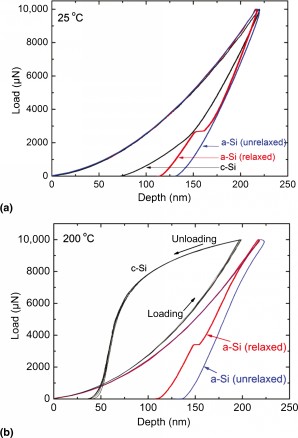Crossref Citations
This article has been cited by the following publications. This list is generated based on data provided by
Crossref.
Kiran, M. S. R. N.
Haberl, B.
Williams, J. S.
and
Bradby, J. E.
2014.
Temperature dependent deformation mechanisms in pure amorphous silicon.
Journal of Applied Physics,
Vol. 115,
Issue. 11,
Kiran, M. S. R. N.
Tran, T. T.
Smillie, L. A.
Haberl, B.
Subianto, D.
Williams, J. S.
and
Bradby, J. E.
2015.
Temperature-dependent mechanical deformation of silicon at the nanoscale: Phase transformation versus defect propagation.
Journal of Applied Physics,
Vol. 117,
Issue. 20,
Budnitzki, M.
and
Kuna, M.
2016.
Stress induced phase transitions in silicon.
Journal of the Mechanics and Physics of Solids,
Vol. 95,
Issue. ,
p.
64.
Budnitzki, M.
and
Kuna, M.
2017.
Experimental and numerical investigations on stress induced phase transitions in silicon.
International Journal of Solids and Structures,
Vol. 106-107,
Issue. ,
p.
294.
Chavoshi, Saeed Zare
Gallo, Santiago Corujeira
Dong, Hanshan
and
Luo, Xichun
2017.
High temperature nanoscratching of single crystal silicon under reduced oxygen condition.
Materials Science and Engineering: A,
Vol. 684,
Issue. ,
p.
385.
Chavoshi, Saeed Zare
and
Xu, Shuozhi
2018.
Temperature-dependent nanoindentation response of materials.
MRS Communications,
Vol. 8,
Issue. 1,
p.
15.
Jarząbek, Dariusz M.
Milczarek, Michał
Nosewicz, Szymon
Bazarnik, Piotr
and
Schift, Helmut
2020.
Size Effects of Hardness and Strain Rate Sensitivity in Amorphous Silicon Measured by Nanoindentation.
Metallurgical and Materials Transactions A,
Vol. 51,
Issue. 4,
p.
1625.
George, Jeena
Mannepalli, Sowjanya
and
Mangalampalli, Kiran S. R. N.
2021.
Understanding Nanoscale Plasticity by Quantitative In Situ Conductive Nanoindentation.
Advanced Engineering Materials,
Vol. 23,
Issue. 9,
Liu, Changlin
Chen, Xiao
Ke, Jinyang
She, Zhongdi
Zhang, Jianguo
Xiao, Junfeng
and
Xu, Jianfeng
2021.
Numerical investigation on subsurface damage in nanometric cutting of single-crystal silicon at elevated temperatures.
Journal of Manufacturing Processes,
Vol. 68,
Issue. ,
p.
1060.
Hull, Katherine L.
and
Abousleiman, Younane N.
2021.
SEM analysis of pop-ins manifested in layered porous geological material.
MRS Communications,
Vol. 11,
Issue. 6,
p.
747.





